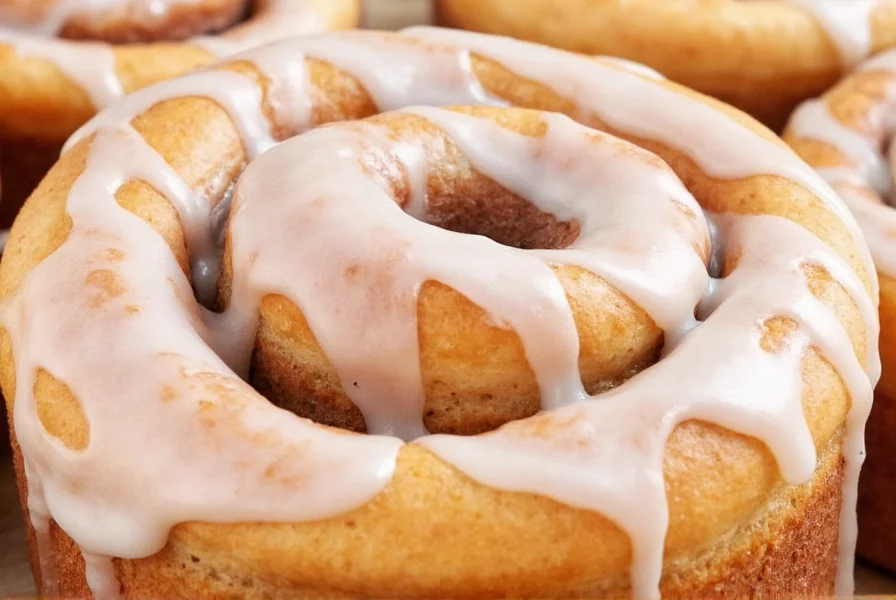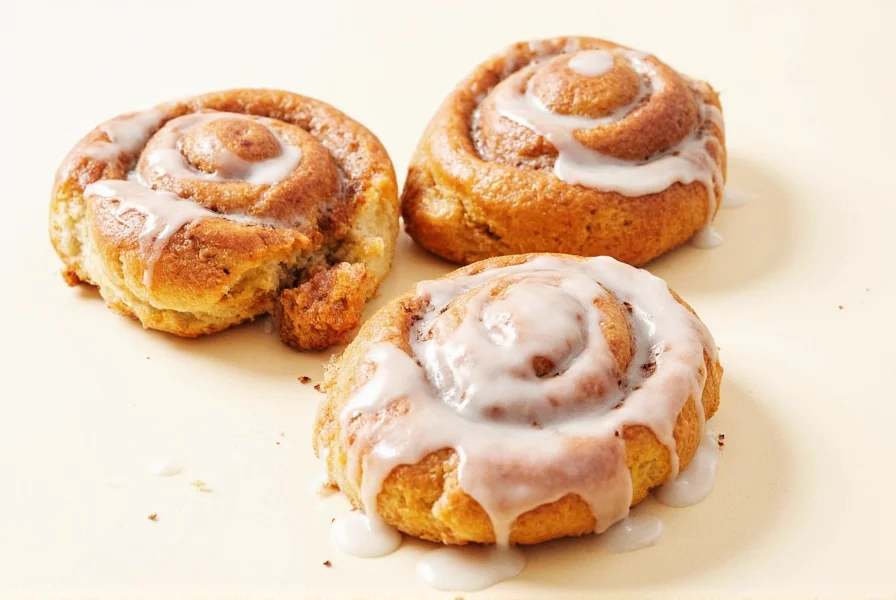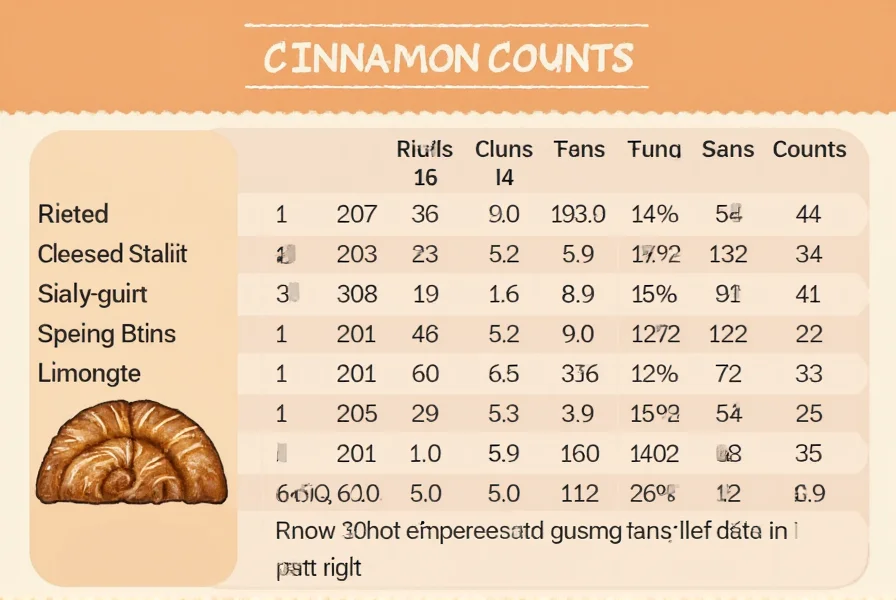Understanding the calorie content of cinnamon buns is essential for those tracking their nutritional intake or managing dietary goals. Whether you're enjoying a homemade treat or purchasing from a bakery, knowing what's in your favorite sweet pastry helps make informed food choices without sacrificing enjoyment.
Factors That Influence Cinnamon Bun Calorie Count
The calorie content of cinnamon buns varies significantly based on several key factors. Being aware of these variables helps you better estimate the nutritional impact of your pastry choice.
Size Matters Most
The single biggest factor affecting cinnamon bun calories is size. What many consider a "standard" cinnamon bun differs dramatically across bakeries and regions:
- Mini cinnamon rolls (2-3 inches diameter): 150-250 calories
- Standard bakery cinnamon bun (3-4 inches): 300-400 calories
- Large gourmet cinnamon roll (5+ inches): 500-800+ calories
- Homemade cinnamon roll (recipe-dependent): 250-600 calories
Ingredient Variations
Different recipes dramatically alter the calorie profile. Commercial bakeries often use enriched dough with higher fat content, while homemade versions can be adjusted for lower calories. Key ingredients affecting calorie count include:
- Dough composition - Butter, eggs, and milk content significantly impact calories
- Filling richness - Brown sugar to butter ratio in the cinnamon swirl
- Frosting type - Cream cheese vs. simple glaze can add 50-150+ extra calories
- Add-ins - Nuts, raisins, or caramel drizzle increase calorie density
| Type of Cinnamon Bun | Approx. Weight | Calories | Total Fat (g) | Carbohydrates (g) | Sugar (g) |
|---|---|---|---|---|---|
| Mini cinnamon roll | 50g | 150-250 | 5-8 | 25-35 | 15-20 |
| Standard bakery bun | 85-100g | 300-400 | 10-15 | 50-60 | 25-35 |
| Large gourmet roll | 150-200g | 500-800 | 20-30 | 70-100 | 40-60 |
| Homemade (basic recipe) | 100g | 280-350 | 8-12 | 50-55 | 20-25 |
Nutritional Context: Where Cinnamon Buns Fit In
While cinnamon buns are undeniably delicious, understanding their place in a balanced diet provides valuable perspective. A single standard cinnamon bun represents approximately 15-20% of a typical 2,000-calorie daily diet. The nutritional profile is predominantly carbohydrates with moderate fat content and minimal protein.
Registered dietitians generally recommend treating cinnamon buns as an occasional indulgence rather than a daily staple. The American Heart Association suggests limiting added sugars to no more than 25g per day for women and 36g for men, which means even a standard cinnamon bun can exceed these recommendations when considering its 25-35g of sugar content.

Smart Strategies for Enjoying Cinnamon Buns Mindfully
You don't need to eliminate cinnamon buns from your diet entirely. Several practical approaches allow you to enjoy these treats while maintaining your nutritional goals:
Portion Control Techniques
Sharing is caring—literally for your calorie count. Splitting a large cinnamon roll with a friend immediately halves your intake. Alternatively, opt for mini versions which provide the flavor experience with fewer calories. Many bakeries now offer "bite-sized" cinnamon rolls specifically for calorie-conscious consumers.
Homemade Healthier Alternatives
Preparing cinnamon buns at home gives you complete control over ingredients. Consider these modifications for lower-calorie cinnamon bun calories:
- Substitute half the butter with unsweetened applesauce
- Reduce sugar by 25% and increase cinnamon for flavor
- Use whole wheat flour for added fiber
- Make a light glaze with powdered sugar and milk instead of heavy frosting
- Add protein powder to the dough for increased satiety
Strategic Timing
Consuming higher-calorie foods when your body can best utilize the energy makes nutritional sense. Enjoying a cinnamon bun earlier in the day gives your body more time to metabolize the carbohydrates. Pairing it with protein (like Greek yogurt) or fiber (like berries) slows sugar absorption and increases fullness.

Comparing Popular Bakery Cinnamon Bun Calories
If you frequently purchase cinnamon buns from commercial bakeries, knowing specific calorie counts helps with informed choices. Here's how some popular options compare:
| Bakery/Brand | Product Name | Calories | Size (g) |
|---|---|---|---|
| Cinnabon | Classic Cinnamon Roll | 880 | 217 |
| Pillsbury | Refrigerated Cinnamon Rolls | 340 | 71 |
| Costco | Kirkland Signature Cinnamon Rolls | 430 | 100 |
| Starbucks | Classic Cinnamon Roll | 510 | 137 |
| Tim Hortons | Old Fashioned Cinnamon Roll | 570 | 130 |
Notice the significant variation between brands. Cinnabon's signature roll contains nearly three times the calories of a standard homemade version. When purchasing store-bought cinnamon buns, checking nutritional information (when available) helps avoid unexpected calorie surges.
Making Informed Choices About Cinnamon Bun Calories
Understanding cinnamon bun calories isn't about restriction—it's about awareness. When you know what's in your favorite pastry, you can make choices aligned with your health goals while still enjoying life's sweet moments. Whether you're tracking calories for weight management, diabetes control, or general wellness, having accurate information empowers your decisions.
Remember that occasional indulgences fit within balanced eating patterns. The key is mindfulness—knowing what you're consuming and why. By applying these insights about cinnamon bun calories, you maintain control over your nutritional journey without feeling deprived.
How many calories are in a homemade cinnamon bun?
A typical homemade cinnamon bun (approximately 100g) contains 280-350 calories. This can vary based on your specific recipe—using less butter or sugar can reduce calories to 250 or lower, while adding nuts, extra frosting, or larger portions can increase calories to 400 or more.
Are there low-calorie cinnamon bun alternatives?
Yes, several lower-calorie alternatives exist. You can make "cinnamon bun" muffins using whole wheat flour and reduced sugar (180-220 calories), create cinnamon swirl bread slices (120-150 calories per slice), or try baked cinnamon apples with whole grain toast for a similar flavor profile with only 100-150 calories.
How do cinnamon roll calories compare to other breakfast pastries?
Cinnamon rolls typically contain more calories than many other breakfast pastries. A standard cinnamon roll (300-400 calories) has more calories than a plain bagel (270), croissant (230), or blueberry muffin (320), but fewer than oversized bakery muffins (500-700). The high sugar and fat content in cinnamon rolls makes them more calorie-dense than many alternatives.
Does the type of frosting affect cinnamon bun calories significantly?
Absolutely. Frosting can add 50-150+ calories to a cinnamon bun. A basic powdered sugar glaze adds about 50-80 calories, while cream cheese frosting typically adds 100-150 calories. Opting for no frosting or a light dusting of powdered sugar instead of heavy frosting can substantially reduce the total calorie count of your cinnamon bun.
Can cinnamon buns fit into a weight loss diet?
Yes, cinnamon buns can fit into a weight loss diet with proper planning. Enjoy a smaller portion (like a mini cinnamon roll at 150-250 calories) occasionally, preferably earlier in the day. Pair it with protein or fiber to increase fullness. Many successful weight loss maintainers practice the 80/20 rule—eating nutrient-dense foods 80% of the time while allowing for planned indulgences the other 20%.











 浙公网安备
33010002000092号
浙公网安备
33010002000092号 浙B2-20120091-4
浙B2-20120091-4